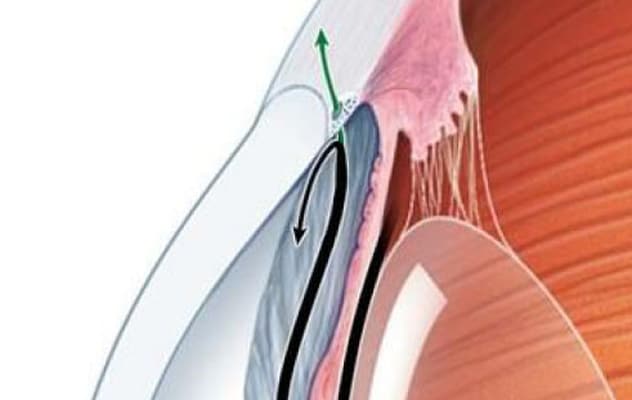Oct. 01, 2021
ضغط العين في مرض الزَرَق الأولي مفتوح الزاوية

ضغط العين في مرض الزَرَق الأولي مفتوح الزاوية
تُظهر الصورة ضغط العين في مرض الزَرَق الأولي مفتوح الزاوية.
Intraocular pressure (IOP) reduction is key to controlling primary open-angle glaucoma (POAG), the second-leading cause of blindness worldwide. "Elevated IOP resulting from increased resistance to aqueous humor outflow is a critical risk factor for POAG and is, thus far, the only causative factor that can be modified," says Arthur J. Sit, M.D., M.S., Ophthalmology, at Mayo Clinic in Rochester, Minnesota. "Pharmacological therapies to reduce elevated IOP are the most common options for controlling or delaying disease progression."
Most common medications used for patients with POAG or ocular hypertension (OHT) lower IOP by increasing uveoscleral drainage or by decreasing production of aqueous humor. However, few medications target the site of abnormality in POAG and OHT: the trabecular meshwork. "Unfortunately, no IOP-lowering treatment is effective for all patients, and previous medications that targeted the trabecular meshwork either worked indirectly or were poorly tolerated," says Dr. Sit.
Netarsudil, a Rho kinase and norepinephrine transporter inhibitor, was approved by the U.S. Food and Drug Administration in 2017 for the reduction of elevated IOP in patients with POAG or OHT. While netarsudil was developed to act on the trabecular meshwork, the mechanism of action for IOP reduction by netarsudil had not previously been investigated in patients with POAG or OHT.
To understand the mechanism of action of netarsudil, Dr. Sit and fellow researchers measured changes in aqueous humor dynamics including trabecular outflow facility, episcleral venous pressure (EVP) and IOP in patients with POAG or OHT following treatment for seven days with netarsudil ophthalmic solution 0.02%. Their phase 2 study was published in the American Journal of Ophthalmology in 2021.
The study's modified intent-to-treat population (n = 18) included all randomized patients who met the following criteria:
- At least one dose of study medication was administered.
- All baseline measurements and post-baseline measurements for outflow facility were collected.
- Mean diurnal IOP was at least 2 mm Hg lower than baseline mean diurnal IOP in the same eye treated with netarsudil (responders).
Patients attended three study visits, beginning with a screening visit (visit 1) conducted up to six weeks prior to the qualification baseline visit (visit 2 on day 1). Patients using existing glaucoma medications were washed out over 1 to 6 weeks depending on the medication. Those who passed the qualification visit then instilled netarsudil 0.02% into one eye and vehicle into the contralateral eye each morning on days 2 through 7. On day 8 (visit 3), the final treatment was administered at 8 a.m., followed by post-treatment assessment.
Results
The primary efficacy endpoint of the study was change in mean diurnal trabecular outflow facility (the average of facility measurements at 1 p.m. and 4 p.m.) on day 8 compared with that on day 1 (baseline). Results included the following:
- Mean diurnal outflow facility increased 0.039 µL/min/mm Hg versus 0.007 µL/min/mm Hg from baseline in the netarsudil- and the vehicle-treated groups, respectively (P < 0.001 versus baseline for netarsudil), a treatment difference of 0.03 µL/min/mm Hg (P ≤ 0.001).
- Mean diurnal IOP change from baseline at day 8 was -4.52 mm Hg for netarsudil versus -0.98 mm Hg for vehicle, a treatment difference of -3.54 mm Hg (P < 0.0001).
- Mean diurnal EVP change from baseline was -0.79 mm Hg in the netarsudil-treated group versus 0.10 mm Hg for vehicle, a treatment difference of -0.89 mm Hg (P < 0.001).
Dr. Sit concludes: "In this study, once-daily dosages of netarsudil ophthalmic solution 0.02% for seven days lowered IOP by improving outflow facility and reducing EVP. Trabecular outflow facility increased by approximately 35% from baseline and 25% versus vehicle-treated controls with netarsudil treatment. The change from baseline in trabecular outflow facility accounts for approximately 80% of the mean change in IOP in the treatment group, which decreased nearly 20% after seven days of once-daily netarsudil treatment."
For more information
Sit AJ, et al. Netarsudil improves trabecular outflow facility in patients with primary open angle glaucoma or ocular hypertension: A phase 2 study. American Journal of Ophthalmology. 2021;226:262.